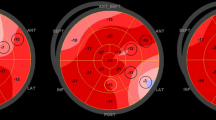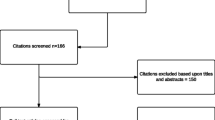Abstract
Objective
Clinical assessment often cannot risk stratify patients hospitalized with chest pain and non-diagnostic electrocardiography (ECG) or myocardial enzymes. An inappropriate admission of patients with non-cardiac chest pain is an enormous cost factor.
Methods
2315 patients who presented in the chest pain unit (CPU) with symptoms suggestive of acute coronary syndrome (ACS) were screened. All patients with relevant changes in ECG or myocardial enzymes were excluded. 268 consecutive patients (mean 58 ± 7 years, 88 men) were prospectively included and underwent echocardiography for left ventricular ejection fraction (LVEF), wall motion score index (WMSI) and strain parameter and a coronary angiography (CA) within 2 ± 1 days after admission.
Results
Anatomically obstructive coronary artery disease (CAD) (≥70 % diameter stenosis) was present in 110 patients (41 %). The incremental value of LVEF, WMSI, and strain parameters to relevant clinical variables was determined in nested Cox models. Baseline clinical data associated with relevant CAD were age [hazard ratio (HR) 1.31, p = 0.03], arterial hypertension (HR 1.39, p = 0.03) and diabetes (HR 1.46, p = 0.001). The addition of endocardial global circumferential strain (GCS) (HR 1.57, p < 0.001) caused the greatest increment in model power (χ 2 = 43.4, p < 0.001). Optimal cut-off value was calculated as -21.7 % for GCS (sensitivity 87 %, specificity 76 %) to differentiate between these patients.
Conclusions
In patients with suspected ACS but without ECG changes or myocardial enzyme abnormalities, myocardial deformation imaging can identify patients at risk. This approach may be applied to improve decision guidance at the CPU for fast discharge of patients with non-cardiac chest pain or prompt cardiological allocation of patients with CAD.
Clinical trial registration
NCT 02357641.



Similar content being viewed by others
Abbreviations
- ACS:
-
Acute coronary syndrome
- AUC:
-
Area under the curve
- CA:
-
Coronary angiography
- CAD:
-
Coronary artery disease
- CI:
-
Confidence interval
- CPU:
-
Chest pain unit
- CK:
-
Creatine kinase
- CT:
-
Coronary computer tomography
- ECG:
-
Electrocardiography
- LVEF:
-
Left ventricular ejection fraction
- GCS:
-
Global circumferential strain
- GLS:
-
Global longitudinal strain
- GRS:
-
Global radial strain
- LV:
-
Left ventricle/ventricular
- MI:
-
Myocardial infarction
- MRI:
-
Agnetic resonance imaging
- NSTE:
-
Non-ST-segment elevation
- PCI:
-
Percutaneous coronary intervention
- ROC:
-
Receiver-operating characteristic
- SD:
-
Standard deviations
- SPECT:
-
Single-photon emission computed tomography
- WMSI:
-
Wall motion score index
References
Murphy NF, MacIntyre K, Capewll S, Stewart S, Pell J, Chalmers J, Redpath A, Frame S, Bpoyd J, McMurray JJ (2004) Hospital discharge rates for suspected acute coronary syndrome between 1990 and 2000: population based analysis. BMJ 328:1413–1414
Ruiz-Bailén M, Romero-Bermejo FJ, Ramos-Cuadra JÁ, Rucabado-Aguilar L, Chibouti-Bouichrat K, Castillo-Rivera AM, Pintor-Mármol A, Expósito-Ruiz M, García MI, Dolores-Pola-Gallego-de-Guzmán M, Gómez-Jiménez J, Torres-Ruiz JM, Ulecia-Martínez M (2011) Evaluation of the performance of echocardiography in acute coronary syndrome patients during their stay in coronary units. Acute Card Care 13:21–29
Bedetti G, Pasanisi EM, Tintori G, Fonseca L, Tresoldi S, Minneci C, Jambrik Z, Ghelarducci B, Orlandini A, Picano E (2005) Stress echo in chest pain unit: the SPEED trial. Int J Cardiol 102:461–467
Jeetley P, Burden L, Stoykova B, Senior R (2007) Clinical and economic impact of stress echocardiography compared with exercise electrocardiography in patients with suspected acute coronary syndrome but negative troponin: a prospective randomized controlled study. Eur Heart J 28:204–211
Shah BN, Balaji G, Alhajiri A, Ramzy IS, Ahmadvazir S, Senior R (2013) Incremental diagnostic and prognostic value of contemporary stress echocardiography in a chest pain unit. Mortality and morbidity outcomes from a real-world setting. Circ Cardiovasc Imaging 6:202–209
Lipiec P, Wejner-Mik P, Krzemińska-Pakuła M, Kuśmierek J, Płachcińska A, Szumiński R, Peruga JZ, Kasprzak JD (2008) Accelerated stress real-time myocardial contrast echocardiography for the detection of coronary artery disease: comparison with 99mTc single photon emission computed tomography. J Am Soc Echocardiogr 21:941–947
Gaibazzi N, Reverberi C, Squeri A, De Iaco G, Ardissino D, Gherli T (2009) Contrast stress echocardiography for the diagnosis of coronary artery disease in patients with chest pain bit without acute coronary syndrome: incremental value of myocardial perfusion. J Am Soc Echocardiogr 22:404–410
Tsutsui JM, Elhendy A, Anderson JR, Xie F, McGrain AC, Porter TR (2005) Prognostic value of dobutamine stress myocardial contrast perfusion echocardiography. Circulation 112:1440–1450
Reant P, Labrousse L, Lafitte S, Bordachar P, Pillois X, Tariosse L, Bonoron-Adele S, Padois P, Deville C, Roudaut R, Dos Santos P (2008) Experimental validation of circumferential, longitudinal, and radial 2-dimensional strain during dobutamine stress echocardiography in ischemic conditions. J Am Coll Cardiol 51:149–157
Choi JO, Cho SW, Song YB, Cho SJ, Song BG, Lee SC, Park SW (2009) Longitudinal 2D strain at rest predicts the presence of left main and three vessel coronary artery disease in patients without regional wall motion abnormality. Eur J Echocardiogr 10:695–701
Eek C, Grenne B, Brunvand H, Aakhus S, Endresen K, Smiseth OA, Edvardsen T, Skulstad H (2010) Strain echocardiography predicts acute coronary occlusion in patients with non-ST-segment elevation acute coronary syndrome. Eur J Echocardiogr. 11:501–508
Sarvari SI, Haugaa KH, Zahid W, Bendz B, Aakhus S, Aaberge L, Edvardsen T (2013) Layer-specific quantification of myocardial deformation by strain echocardiography may reveal significant CAD in patients with non-ST-segment elevation acute coronary syndrome. JACC Cardiovasc Imaging 6:535–544
Reisner S, Lysyansky P, Agmon Y, Mutlak D, Lessick J, Friedman Z (2004) Global longitudinal strain: a novel index of left ventricular systolic function. J Am Soc Echocardiogr 17:630–633
Tonino PA, De Bruyne B, Pijls NH, Siebert U, Ikeno F, van’t Veer M, Klauss V, Manoharan G, Engstrøm T, Oldroyd KG, Ver Lee PN, MacCarthy PA, Fearon WF, FAME Study Investigators (2009) Fractional flow reserve versus angiography for guiding percutaneous coronary intervention. N Engl J Med 360:213–224
Damman P, van Geloven N, Wallentin L, Lagerqvist B, Fox KA, Clayton T, Pocock SJ, Hirsch A, Windhausen F, Tijssen JG, de Winter RJ (2012) Timing of angiography with a routine invasive strategy and long-term outcomes in non-ST-segment elevation acute coronary syndrome: a collaborative analysis of individual patient data from the FRISC II (Fragmin and Fast Revascularization During Instability in Coronary Artery Disease), ICTUS (Invasive Versus Conservative Treatment in Unstable Coronary Syndromes), and RITA-3 (Intervention Versus Conservative Treatment Strategy in Patients With Unstable Angina or Non-ST Elevation Myocardial Infarction) trials. JACC Cardiovasc Interv 5:191–199
Cury RC, Shash K, Nagurney JT, Rosito G, Shapiro MD, Nomura CH, Abbara S, Bamberg F, Ferencik M, Schmidt EJ, Brown DF, Hoffmann U, Brady TJ (2008) Cardiac magnetic resonance with T2-weighted imaging improves detection of patients with acute coronary syndrome in the emergency department. Circulation 118:837–844
Ingkanisorn WP, Kwong RY, Bohme NS, Geller NL, Rhoads KL, Dyke CK, Paterson DI, Syed MA, Aletras AH, Arai AE (2006) Prognosis of negative adenosine stress magnetic resonance in patients presenting to an emergency department with chest pain. J Am Coll Cardiol 47:1427–1432
Heitner JF, Klem I, Rasheed D, Chandra A, Kim HW, Van Assche LM, Parker M, Judd RM, Jollis JG, Kim RJ (2014) Stress cardiac MR imaging compared with stress echocardiography in the early evaluation of patients who present to the emergency department with intermediate-risk chest pain. Radiology 271:56–64
Miller CD, Hwang W, Case D, Hoekstra JW, Lefebvre C, Blumstein H, Hamilton CA, Harper EN, Hundley WG (2011) Stress CMR imaging observation unit in the emergency department reduces 1-year medical care costs in patients with acute chest pain: a randomized study for comparison with inpatient care. JACC Cardiovasc Imaging 4:862–870
Miller CD, Case LD, Little WC, Mahler SA, Burke GL, Harper EN, Lefebvre C, Hiestand B, Hoekstra JW, Hamilton CA, Hundley WG (2013) Stress CMR reduces revascularization, hospital readmission, and recurrent cardiac testing in intermediate-risk patients with acute chest pain. JACC Cardiovasc Imaging 6:785–794
Miller CD, Hoekstra JW, Lefebvre C, Blumstein H, Hamilton CA, Harper EN, Mahler S, Diercks DB, Neiberg R, Hundley WG (2012) Provider-directed imaging stress testing reduces health care expenditures in lower-risk chest pain patients presenting to the emergency department. Circ Cardiovasc Imaging 5:111–1118
Cury RC, Feutchner G, Pena CS, Janowitz WR, Katzen BT, Ziffer JA (2008) Acute chest pain imaging in the emergency department with cardiac computed tomography angiography. J Nucl Cardiol 15:564–575
Litt HI, Gatsonis C, Snyder B, Singh H, Miller CD, Entrikin DW, Leaming JM, Gavin LJ, Pacella CB, Hollander JE (2012) CT angiography for safe discharge of patients with possible acute coronary syndromes. N Engl J Med 366:1393–1403
Tsutsui JM, Xie F, Cloutier D, Kalvaitis S, Elhendy A, Porter TR (2008) Real-time dobutamine stress myocardial perfusion echocardiography predicts outcome in the elderly. Eur Heart J 29:377–385
Nucifora G, Schuijf JD, Delgado V, Bertini M, Scholte AJ, Ng AC, van Werkhoven JM, Jukema JW, Holman ER, van der Wall EE, Bax JJ (2010) Incremental value of subclinical left ventricular systolic dysfunction for the identification of patients with obstructive coronary artery disease. Am Heart J 159:148–157
Smedsrud MK, Sarvari S, Haugaa KH, Gjesdal O, Ørn S, Aaberge L, Smiseth OA, Edvardsen T (2012) Duration of myocardial early systolic lengthening predicts the presence of significant coronary artery disease. J Am Coll Cardiol 18(60):1086–1093
Gjesdal O, Helle-Valle T, Hopp E, Lunde K, Vartdal T, Aakhus S, Smith HJ, Ihlen H, Edvardsen T (2008) Noninvasive separation of large, medium, and small myocardial infarcts in survivors of reperfused ST-elevation myocardial infarction: a comprehensive tissue Doppler and speckle-tracking echocardiography study. Circ Cardiovasc Imaging 1:189–196
Cicutti N, Rakusan K, Downey HF (1994) Coronary artery occlusion extends perfusion territory boundaries through microvascular collaterals. Basic Res Cardiol 89:427–437
Gjesdal O, Hopp E, Vartdal T, Lunde K, Helle-Valle T, Aakhus S, Smith HJ, Ihlen H, Edvardsen T (2007) Global longitudinal strain measured by two-dimensional speckle tracking echocardiography is closely related to myocardial infarct size in chronic ischaemic heart disease. Clin Sci (Lond) 113:287–296
Acknowledgments
MB designed the study and managed research process, MB and JS chaired data acquisition and analysis and interpretation of results, MB and SH wrote the report. MB, JS and SH had full access to all of the data in the study and took responsibility for the integrity of the data and the accuracy of the data analysis. Data were analyzed by NG, TR, EA and KU. AK contributed to statistical interpretation of results. NM and EA contributed to data analysis and interpretation and reviewed the report. NM, JS and KU contributed to the writing of the report.
Author information
Authors and Affiliations
Corresponding author
Ethics declarations
Conflict of interest
All authors declare no conflicts of interest.
Additional information
J. Schroeder and S. Hamada distributed equally.
Rights and permissions
About this article
Cite this article
Schroeder, J., Hamada, S., Gründlinger, N. et al. Myocardial deformation by strain echocardiography identifies patients with acute coronary syndrome and non-diagnostic ECG presenting in a chest pain unit: a prospective study of diagnostic accuracy. Clin Res Cardiol 105, 248–256 (2016). https://doi.org/10.1007/s00392-015-0916-2
Received:
Accepted:
Published:
Issue Date:
DOI: https://doi.org/10.1007/s00392-015-0916-2




